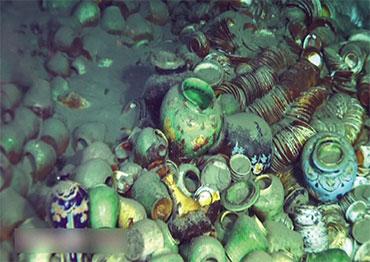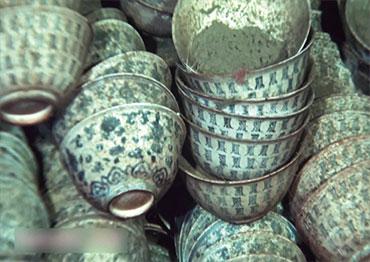China has lost many precious cultural relics to the seas over its maritime history, particularly the South China Sea.
In 1984, British explorer Michael Hatcher found the Geldermalsen, a Dutch East India Company merchant ship, in the South China Sea. Sunk in 1752 near Binkan Island, Indonesia, it was full of porcelain and gold – more than one million items were salvaged in total. However, in order to maximize profits, he only inventoried 239,000 pieces of blue and white porcelain, 125 gold ingots and two bronze cannons engraved with the initials of the Dutch East India Company. The remaining pieces of blue and white porcelain and other cultural relics were considered to have little circulation value and destroyed.
In 1986, Hatcher obtained an auction permit under the pretext that the Geldermalsen was unclaimed by any nation. He commissioned Christie’s Amsterdam to auction the artifacts. But when China’s National Cultural Heritage Administration wanted to stop the auction, it could not find any valid legal basis to force the return of the relics in the UN Convention on the Law of the Sea.
Buying them back was the only feasible way. The Administration dispatched two experts, Feng Xianming and Geng Baochang, to Amsterdam with US$30,000. But the starting prices were far beyond what they expected, and the men could not afford to enter a single bid during the three-day auction. In the end, every one of the nearly 240,000 pieces went to overseas bidders.
The incident was a wake-up call for Chinese marine archaeologists. In March 1987, the Administration took the lead in establishing the National Coordination Group for Underwater Archaeology, kickstarting underwater archaeology in China. The Administration sent teams to Japan, the Netherlands and Australia to study diving and cutting-edge underwater archaeology techniques, and created a team of more than 10 experts.
Also in 1987, when the British searched the archives of the East India Company, they found that the Rheinberg sank in the Taishan and Yangjiang waters of Guangdong Province. The ship was logged as carrying six chests of silver and more than 300 tons of tin ingots.
In August of that year, the Guangzhou Salvage Bureau cooperated with a British maritime expedition company to excavate the shipwreck.
During the search, they instead stumbled upon an ancient wooden wreck from the early Southern Song Dynasty (1127-1279). Later named Nanhai No 1 (Nanhai means South China Sea), it had been transporting mostly porcelain when it sank 24 meters below the surface. This was the first shipwreck site found in China representing the Maritime Silk Road. Since its discovery, over 60,000 cultural relics have been recovered from it.
Nanhai No 1 was sailing from Quanzhou, Fujian Province when it sank in the waters of Yangjiang, Guangdong Province. Dormant for more than 800 years, the wreck was encased in silt, which greatly slowed the decomposition of its hull and cargo. In its 13 compartments, archaeologists found hundreds of tons of goods, including porcelain, coins, gold and silver, lacquerware, metal products, and other popular export commodities, many of which are valuable treasures.
Nanhai No 1 is the earliest, largest and best-preserved ocean-going merchant ship among the maritime shipwrecks found in the world so far. More than 200,000 cultural relics have been salvaged, all important for studying the ancient history of shipbuilding, ceramics and trade in Southeast Asia.
The porcelain is from the Song and Yuan dynasties, roughly from the 10th century to 14th century. Extremely rare, antique collectors compete for even fragments of porcelain from this period. To archaeologists, however, protecting the hull of the Southern Song wreck was more important than excavating the artifacts.
According to international practice at that time, salvagers first remove the artifacts, then disassemble the ship, protect the pieces and reassemble it off site. If that had been the case, the whole ship would have been damaged. So, the archaeological team, after much deliberation, proposed a bottomless metal container to enclose the hull.
The container’s sides were sharpened to dig into the seabed. Then divers dug out the surrounding area and slid steel beams across the bottom so a crane could lift it in one piece. The approach had never been attempted – but it worked.
In December 2007, Nanhai No 1 was moved to the Maritime Silk Road Museum of Guangdong, which was built to house it. The museum has a large tank with the same water qualities as the wreck site, where archaeologists can slowly excavate the vessel as visitors look on. This approach to conservation, salvage and display is among the first of its kind in the world.
The successful recovery of Nanhai No 1 greatly encouraged Chinese underwater archaeologists, as there are many more shipwreck sites waiting to be explored.
In 2011, the Shanghai Municipal Bureau of Cultural Heritage surveyed the waters of the Yangtze estuary, where visibility is almost nil.
In 2015, a relatively well-preserved wreck of an iron ship was discovered in the Chongming Hengsha water zone in Shanghai named Changjiangkou No 1. Subsequently, another large and well-preserved wooden wreck was found to its north, Changjiangkou No 2.
After several years of underwater exploration, the origins of Changjiangkou No 2 were revealed. The wreck is a wooden sailing ship dating to the reign of Qing Dynasty Emperor Tongzhi (1861-1875). The ship is a flat-bottomed vessel widely used for transport in Shanghai during the Ming and Qing dynasties.
The wreck is located at a depth of 8 to 10 meters, its hull buried in 5.5 meters of silt. It is 38.1 meters long, 9.9 meters wide, and has 31 compartments. So far, a large number of fine cultural relics such as porcelain from the famed Jingdezhen kilns have been found, along with Yixing purple sand ware (a common export to Europe at the time), smoking pipes from Vietnam, and remnants of wooden water buckets.
The Changjiangkou No 2 wreck marks another milestone in Chinese underwater archaeology. It is among the largest, most complete and well-preserved ancient wooden shipwrecks in the world, and carried a huge number of artifacts.
However, the Changjiangkou No 2 is considered a shallow water excavation.

 Old Version
Old Version




